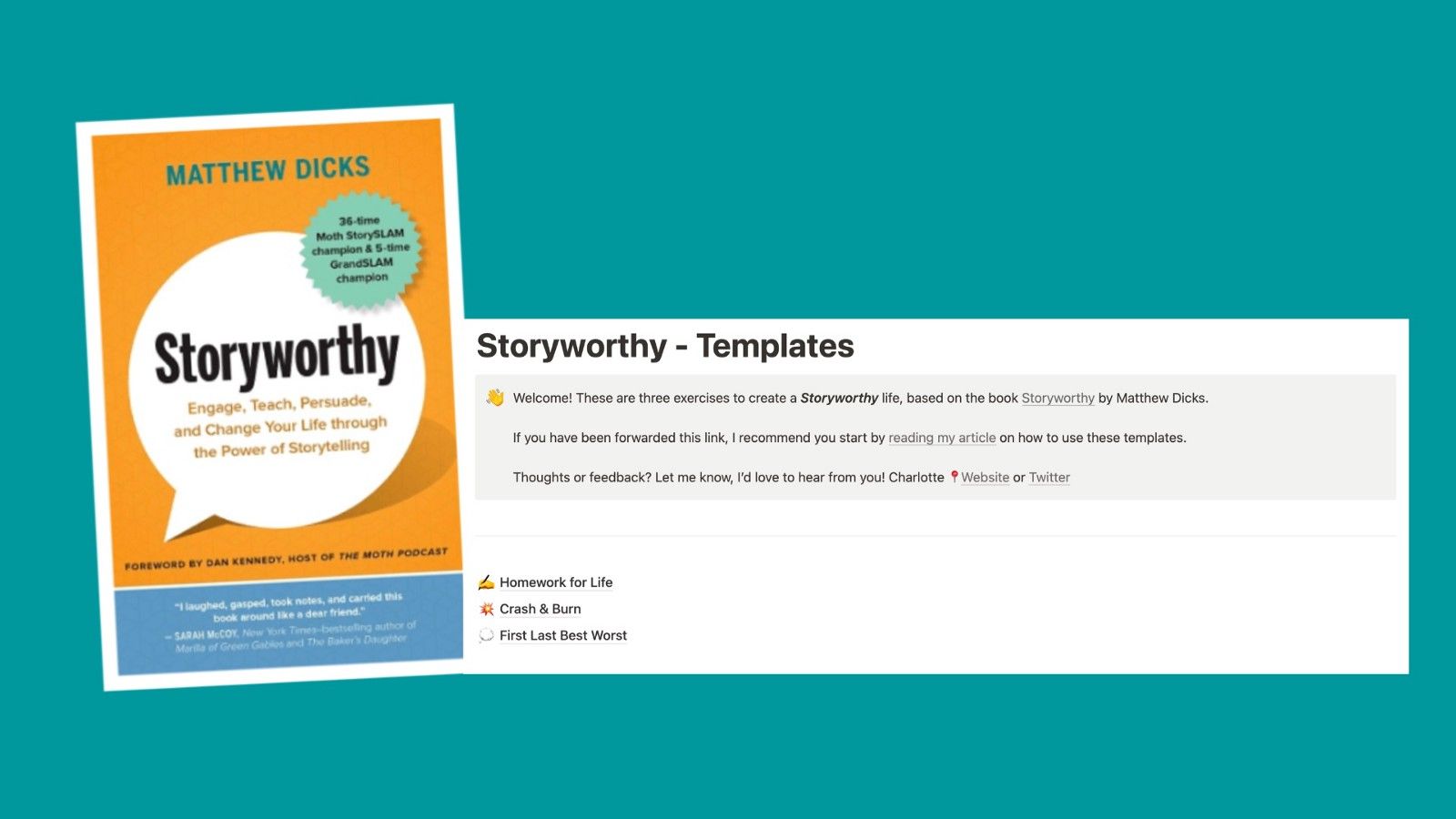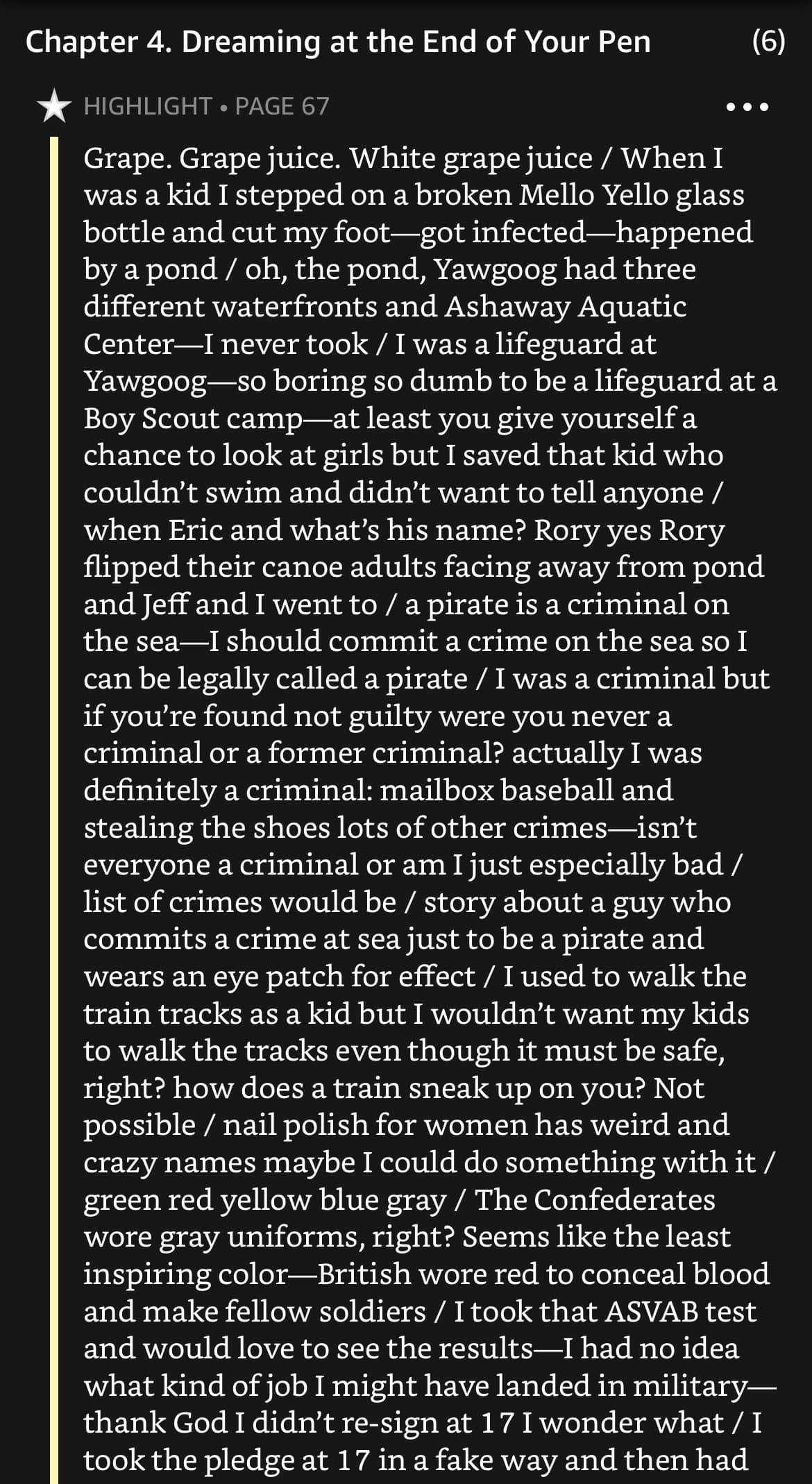How To Make Your Life Storyworthy

What makes a life ‘storyworthy’?
Is it the life-altering, exciting, tragic or heroic moments? Is it about making significant changes or achieving outsized success, fame, money?
According to Matthew Dicks, it doesn’t need to be. He’s a bestselling author, columnist, playwright, and 53-time Moth StorySLAM champion and 7-time GrandSLAM champion — so he knows a thing or two about what makes a good story.
Matthew says it’s about the little, everyday moments. The ones that are so easy to miss, dismiss, and forget.
They happen to all of us, all the time. The problem is we fail to notice them or recognize their importance, and when we do see them, we don’t record them. They get lost in the busyness of life.
Making your life storyworthy means paying attention to what is happening in your day to day, no matter how small or insignificant it may seem.
In this post, I’m sharing three exercises from Matthew’s book, Storyworthy, designed to help you spot and collect your moments. To make it easy to get started, I’ve created some ready to use templates for you.
Before we get to the details, you might need a bit more convincing about why this is important. Why should you spend your precious time recording small, seemingly meaningless moments from your life? Who cares?
According to Matthew, one of the best life skills you can acquire is knowing how to recognise these stories and effectively share them in the most compelling way.
This is not just valuable for people like him who do this for a living. Matthew has seen time and time again how paying attention to your stories leads to a more enjoyable existence. You’ll start to see how the meaningful moments you experience every day contribute to your life and the lives of those around you.
You’ll start to know and understand yourself better. You’ll avoid living life on autopilot, unable to recall what you did yesterday, last week or last year.
Here’s how he puts it in the book:
Finding new stories both fills in and fills out my life. They bring breadth and meaning to my life. Recalling a forgotten moment from your life or suddenly seeing it as more than what you once thought can expand the boundaries of your perceived life, while filling in gaps and connecting disparate memories into a more complete picture. Stories will both fill in the holes in the mental map of your life and help you to see how expansive that map truly is. It’s priceless.
Make it your mission to find, see, remember, and identify stories, and you will begin to see your life in a new and more compelling light.
Let’s jump into the exercises.
Homework for Life
Matthew decided that at the end of every day, he’d reflect on his day and ask himself one simple question:
If I had to tell a story from today — a five-minute story onstage about something that took place over the course of this day — what would it be?
Just a sentence or two that captures the moment from the day. Just enough to remember the moment and recall it clearly at a later date.
It’s rarely a great story. Most of the time, it’s not even a good story. But it’s a story. Something that made that day different from the rest.
The key is to do this every day and to keep it short. By telling yourself it’s just one or two sentences a day, you’ll be more likely to stick with it.
It will take you less than five minutes a day, and soon, you will start noticing a few things:
- Time slows down. You don’t feel like every day feels the same anymore.
- You start seeing the storyworthy moments as they’re happening. You develop an eye for them.
- You start to think of recovered memories: forgotten moments from your past that have returned to your mind through this process. Just add those to your list as they come up.
As you sharpen your storytelling lens, you’ll begin to see your life is filled with stories. Moments of real meaning that you have never noticed before. You’ll start appreciating your life and the people in it more. Your life matters, your stories matter.
What you do with these stories is up to you. Matthew uses them to craft stories to use on stage. He goes hunting for the best stories, looking for patterns and connections. For you, it could be simply about recording the smallest moments, so they don’t get lost. Or about showing yourself your life is more diverse and meaningful than previously believed.
If you want to learn more about the story behind this exercise, I recommend listening to Matthew’s Tedx Talk on Homework for Life.
Crash & Burn
This is an exercise in stream-of-consciousness writing, similar to long-form journaling that I’ve written about before.
The difference is that here you are literally writing down whatever words enter your mind; it does not need to make any sense.
It’s the best way to resurrect old and forgotten memories that have been lost to you. Surprising, significant associations between the past and present will come up, making your life brighter and sharper with every new memory discovered. According to Matthew, the reason for this is simple:
We are the sum of our experiences, the culmination of everything that has come before. The more we know about our past, the better we know ourselves.
Just set a ten-minute timer and start writing. You can begin any way you want, but a tip would be to write about an object in your room.
To give you an idea, here’s an example from the book. There are just three rules to keep in mind.

Don’t get attached to any one idea
The goal is to let unexpected ideas intersect and overrun current ones. So it doesn’t matter how intriguing your idea may be; you need to move to the next one the moment it pops into your head.
Don’t judge any thought or idea that appears in your mind
Don’t allow your mind to stop you from doing this exercise. No matter how silly, nonsensical, absurd or embarrassing it may be — if you’re thinking it, you need to write it down. Ignore grammar, punctuation or capitalization.
Don’t allow your fingers to stop moving
You must continue writing words even when your mind is blank. Have a category at the ready in case you get stuck. Matthew uses colors. When he has no other thought in his mind, he begins listing colors on the page until one of them triggers a thought or memory. This can be anything, as long as your list is long and familiar to you (for example countries, animals, cheeses).
At the end of a session, you can go through and see which stories and memories are worth thinking and writing more deeply about. It’s pretty amazing what the mind can come up with if you just let it run wild.
First Last Best Worst
Lastly, a story-finding exercise you can do by yourself but is even better with others. The idea is to use prompts to trigger memories. For each prompt, you fill in the first word or words that come to mind.
First, Last, Best Worst — Kiss; Breakup; Holiday; etc.
Just like with the previous exercises, you will find yourself filling in and filling out your life, making connections you had never thought about before and expanding your memory beyond what you thought possible.
Get Started with These Templates
The hardest part is getting started.
To help, I’ve created a Google Sheets template and Notion template for each exercise. All you need to do is make a copy, save it, and get started.
I recommend starting with Homework For Life and doing this every day for 30 days. Make it a habit. There must be five minutes you can spare, somewhere in your day (even if it’s while brushing your teeth before going to bed).
After that, keep going and see if you can add a Crash & Burn session 2–3 per week. This style of stream-of-consciousness writing is incredible, and you’ll be amazed by the things you come up with if you allow yourself the space.
Once you start seeing and believing the benefits of these exercises, do an FLBW game now and then with someone important in your life. Sharing your stories with other people will make you feel more connected than ever (this is the one I need to work on the most 🙋♀️).
I’ll leave you with the words of Neil Gaiman for final motivation:
“Everybody has a secret world inside of them. All of the people in the whole world, I mean everybody — no matter how dull and boring they are on the outside. Inside them they’ve all got unimaginable, magnificent, wonderful, stupid, amazing worlds… Not just one world. Hundreds of them. Thousands, maybe.”
PS — Reach out if need help accessing or using the templates. If you don’t have Notion or Google Sheets, you can create an account for free.
Member discussion